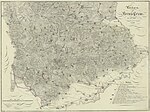Ipf (mountain)

The Ipf is a mostly treeless mountain (668 metres (2,192 ft) high), near Bopfingen, Ostalbkreis, Baden-Württemberg, Germany, with a prehistoric hill fort on its top. The fort is situated on an isolated hill, with a flattened summit surrounded by a stone wall, ditch and large counterscarp (outer bank). The overall diameter is about 180 metres (590 ft). Extensive ramparts traverse the slopes to protect a large enclosed area and entranceway. There is evidence of occupation from the Bronze Age (Urnfield culture) through the Iron Age to the early Celtic La Tene period, a span of almost a thousand years (1200 BC – 300 BC). The summit was already levelled, fortified and densely settled in the Urnfield period. During the early Iron Age Hallstatt period and into the early La Tène period the Ipf was an important 'princely seat' – a regional centre of power and aristocratic residence with long-distance trade connections, including with Greece and Italy.
Excerpt from the Wikipedia article Ipf (mountain) (License: CC BY-SA 3.0, Authors, Images).Ipf (mountain)
Keltenweg (Ipf), Verwaltungsgemeinschaft Bopfingen
Geographical coordinates (GPS) Address Nearby Places Show on map
Geographical coordinates (GPS)
| Latitude | Longitude |
|---|---|
| N 48.870555555556 ° | E 10.356388888889 ° |
Address
Ipf
Keltenweg (Ipf)
73441 Verwaltungsgemeinschaft Bopfingen
Baden-Württemberg, Germany
Open on Google Maps











